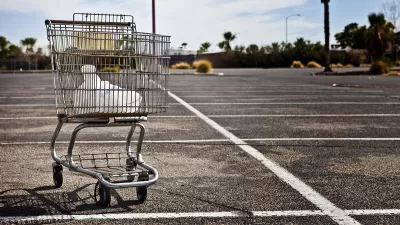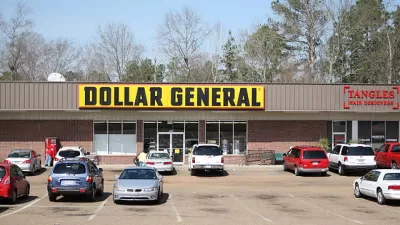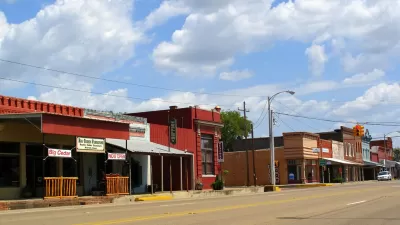Opponents of dollar stores argue that dollar stores are the mortal enemy of grocery stores. Is this really true?

As dollar stores grow in popularity, some municipalities have tried to crack down on them. I have always thought of dollar stores as an amenity—but some politicians claim that dollar stores are so efficient that they make it impossible for regular grocery stores to compete, which in turn is bad because neighborhood residents cannot easily access the fresh fruits and vegetables that are only accessible at grocery stores.
This argument is based on the assumption that grocery stores and dollar stores cannot coexist—that is, that a grocery store is a natural monopoly that cannot survive competition, much like certain public utilities. In middle-class urban neighborhoods, this assumption would obviously be silly—but perhaps it might be true in low-income urban areas* with low buying power.
I work in Central Islip, a low-income Long Island suburb where a Family Dollar and a grocery store are neighbors in a strip mall across the street from a commuter train station. So I am predisposed to think that even in low-income areas, the "natural monopoly" theory is wrong. But perhaps this relationship is unusual, and Central Islip is simply not poor enough to disprove the theory. So to examine the argument more closely, I decided to look at low-income parts of two cities that have recently passed anti-dollar store legislation: Tulsa and New Orleans.
In Tulsa, I focused on the lower-income north side of Tulsa, and found nine Dollar General stores in that area.** Three of the Dollar Stores were within half a mile of a grocery store; the closest was just .2 mile away.*** What about the other six locations? All were within one to two miles of a grocery; the least convenient location, at 2811 North Peoria is 1.3 miles from a Quiktrip at 1513 N. Peoria, and 2.5 miles from a much larger Las Americas supermarket at 2415 E. Admiral. Admittedly, 2.5 miles is not really walking distance—but Tulsa is a low-density, auto-oriented city where not much is within walking distance of anything else; the North Peoria location in a zip code (74106) with just over 2400 people per square mile, lower than the citywide average for car-oriented cities like Houston and Atlanta. Although car ownership is low here by Tulsa standards, even in 74106 over three-quarters of households have a car. For car-owning households, a two-mile trip to a grocery store is not particularly inconvenient.
In New Orleans, the city’s anti-dollar store legislation is limited to the New Orleans East area, which has four Dollar General stores in about a dozen square miles. Of the four stores, all but one were within 0.6 miles of a supermarket, and the fourth was virtually next door to a convenience store and 1.1 miles from a more significant grocery store.*****
It therefore appears that even in a low-density city, a large minority of dollar stores are within a short walk of grocery stores, and the rest are within a long walk or a very short drive. In a medium-density city like New Orleans, most dollar stores are within walking distance of grocery stores. So the “natural monopoly” claim seems inapplicable to urban America.
I note that the anti-dollar-store argument would be more persuasive if dollar stores were the only competition to traditional grocery stores. Of course this is not the case. Even in Tulsa, anyone with access to a car can get groceries at a Wal-Mart, or get a more limited selection of groceries at a national pharmacy such as Walgreen’s or CVS. In New Orleans East, a vehicle is not always necessary to reach these destinations—in addition to a Wal-Mart, this area has three Walgreens stores and a CVS. So even where grocery stores are closing, dollar stores are not the only reason.
*And perhaps in certain rural areas as well, where low population density limits the competitiveness of grocery stores.
**The addresses are 1225 E. 46th, 1906 N. Harvard, 744 E. Pine, 3932 and 7854 E. Admiral Place, 2811 and 6510 North Peoria, 1820 N. Lewis, and 1115 N. Sheridan. Because dollar stores tend to cluster together, I chose to focus only on one chain. A more extensive study might include other chains.
***The 6510 N. Peoria address is near a Warehouse Market at 6230 N. Peoria. In addition, the North Lewis store is near a Save-A-Lot at 1526 North Lewis, and the North Sheridan store is near a Warehouse Market at 845 N. Sheridan.
****The addresses were 10600 Chef Menteur Highway (.2 miles from Chef’s Market at 10833 Chef Menteur, and also 0.6 miles from a Winn Dixie), 11020 Morrison Road (0.5 miles from Read Supermarket at 7045 Read Blvd.), 6500 Downman (0.6 miles from Downman Supermarket at 4827 Downman Road), and 5700 Crowder (about a block from Sam’s Meat Market at 8426 Interstate 10 Service Road, and 1.1 miles from Sohana Grocery at 9000 Chef Menteur).

Alabama: Trump Terminates Settlements for Black Communities Harmed By Raw Sewage
Trump deemed the landmark civil rights agreement “illegal DEI and environmental justice policy.”

Study: Maui’s Plan to Convert Vacation Rentals to Long-Term Housing Could Cause Nearly $1 Billion Economic Loss
The plan would reduce visitor accommodation by 25% resulting in 1,900 jobs lost.

Why Should We Subsidize Public Transportation?
Many public transit agencies face financial stress due to rising costs, declining fare revenue, and declining subsidies. Transit advocates must provide a strong business case for increasing public transit funding.

Paris Bike Boom Leads to Steep Drop in Air Pollution
The French city’s air quality has improved dramatically in the past 20 years, coinciding with a growth in cycling.

Why Housing Costs More to Build in California Than in Texas
Hard costs like labor and materials combined with ‘soft’ costs such as permitting make building in the San Francisco Bay Area almost three times as costly as in Texas cities.

San Diego County Sees a Rise in Urban Coyotes
San Diego County experiences a rise in urban coyotes, as sightings become prevalent throughout its urban neighbourhoods and surrounding areas.
Urban Design for Planners 1: Software Tools
This six-course series explores essential urban design concepts using open source software and equips planners with the tools they need to participate fully in the urban design process.
Planning for Universal Design
Learn the tools for implementing Universal Design in planning regulations.
Smith Gee Studio
Alamo Area Metropolitan Planning Organization
City of Santa Clarita
Institute for Housing and Urban Development Studies (IHS)
City of Grandview
Harvard GSD Executive Education
Toledo-Lucas County Plan Commissions
Salt Lake City
NYU Wagner Graduate School of Public Service






























